
3
Table of contents
1 Introduction ............................................................................................................................................4
1.1 Instructions ...............................................................................................................................................4
1.2 Intended Use ............................................................................................................................................4
1.3 Safety Instructions ....................................................................................................................................4
1.4 Safety Marking .........................................................................................................................................5
1.5 Environment .............................................................................................................................................5
2 Product Description ...............................................................................................................................6
2.1 Function ...................................................................................................................................................6
2.2 Important Features ...................................................................................................................................6
2.3 Technical data ..........................................................................................................................................6
2.4 Device Overview ......................................................................................................................................7
2.5 Delivery Of The Applicator .......................................................................................................................8
3 Installation ..............................................................................................................................................9
3.1 Mounting Device ......................................................................................................................................9
3.1.1 Mounting Applicator ....................................................................................9
3.1.2 Mounting Tamp .................................................................................................................................10
3.2 Connections ............................................................................................................................................11
4 Adjustments .........................................................................................................................................12
4.1 Mechanical Adjustments ........................................................................................................................12
4.1.1 Adjustment the Pad Orientation in the Takeover Position ................................................................12
4.1.2 Setting the Blow Tube.......................................................................................................................13
4.2 Pneumatic Adjustments ..........................................................................................................................14
4.2.1 Function Control Valves ....................................................................................................................14
4.2.2 Throttle Valves at the Valve Block ....................................................................................................15
4.2.3 Throttle Valve at the Cylinder ...........................................................................................................16
5 Operation ..............................................................................................................................................17
5.1 Setting the Operating Mode and Delay Times .......................................................................................17
5.1.1 Takeover the label from printer to the applicator ....................................................................................17
5.1.1 DIP Switches ....................................................................................................................................18
5.1.2 Potentiometer ...................................................................................................................................18
5.1.3 Read Settings of Potentiometers ......................................................................................................19
5.1.4 Operating Mode ................................................................................................................................19
5.2 Pre-Dispense Key ..................................................................................................................................20
5.3 Peel Position ..........................................................................................................................................21
5.4 Normal Operation ...................................................................................................................................21
6 PLC Interface ........................................................................................................................................22
6.1 Comments on the Signals ......................................................................................................................22
6.2 Circuit Diagrams of Inputs and Outputs .................................................................................................24
6.3 Examples for Circuits to Creating an External Start Signal ....................................................................25
7 Error Messages ....................................................................................................................................26
7.1 Printer Error Messages ..........................................................................................................................26
7.2 Applicator Error Messages .....................................................................................................................26
8 Function Of The LED's On The PCB ...................................................................................................27
9 Declaration ............................................................................................................................................28
9.1 EC Declaration of Incorporation .............................................................................................................28
9.2 EC Declaration of Conformity .................................................................................................................29
10 Index ......................................................................................................................................................30





















